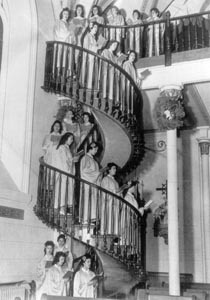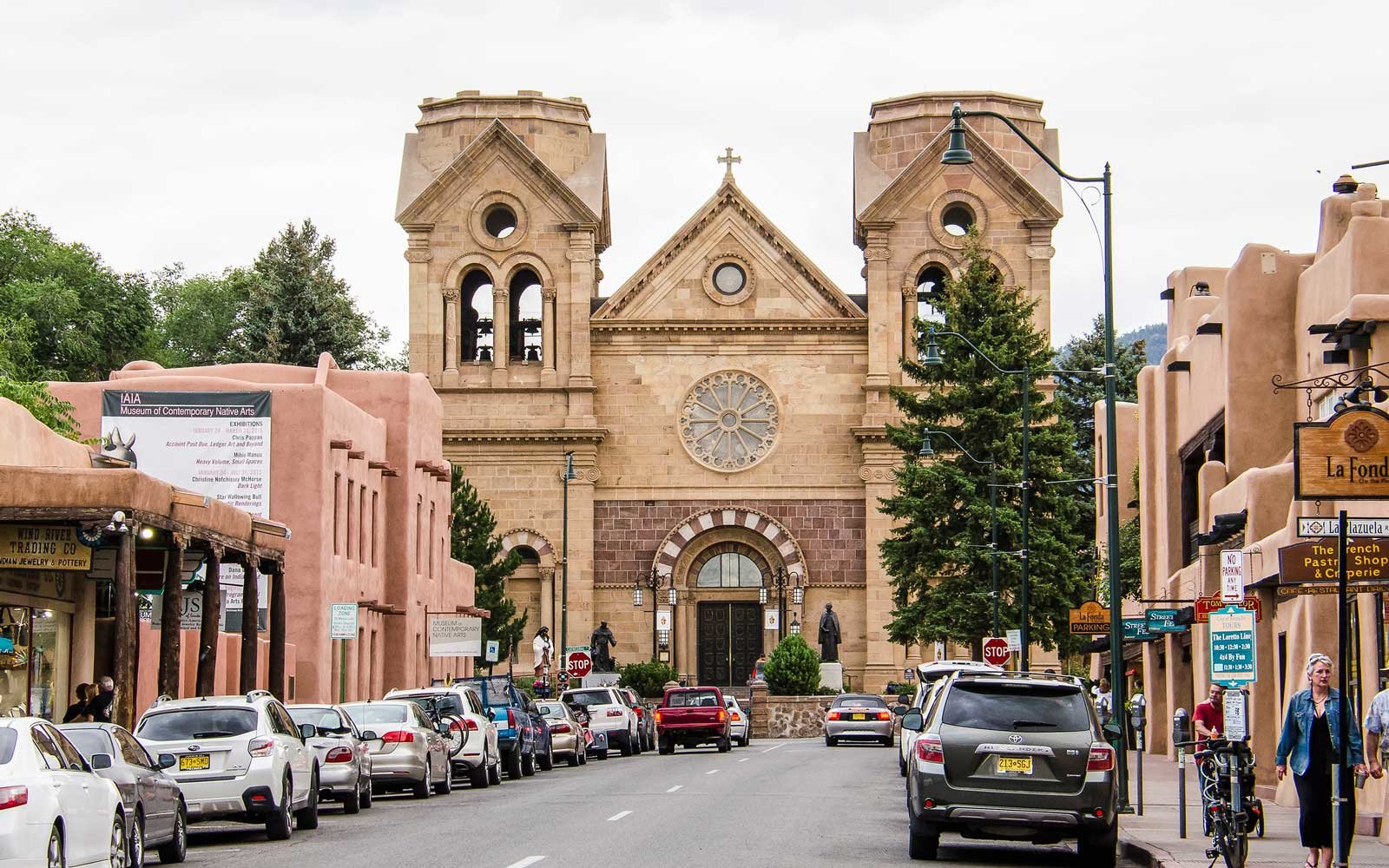Today we celebrate the 47th State to join the Union. Although the New Mexico Territory was established on September 9, 1850; New Mexico did not achieve statehood until January 6, 1912. Civil war and slavery stood in her way.
In 1861 an amendment to the Constitution would have allowed territories to enter the Union as slave states if slavery was lawful in the territory at the time of Statehood. Although Black Slavery in the New Mexico Territory (which included all of Arizona and parts of Colorado) was almost unheard of, Native American slaves were commonplace. Rather than allow another slave state to join the Union, congress tabled the proposition of the state of New Mexico for some 50 odd years. What I find most unsettling is that New Mexico, a fairly young state, suffered the highest number of servicemen to loose their lives during World War II. Perhaps that was due to Code Talkers.
When Hubby and I visited New Mexico years ago, we made it a point to spend time in Santa Fe. The city has its charm, its market square and rich artist community.
While these attractions held a certain appeal, ours was a pilgrimage to see firsthand the Miraculous Staircase of Loretto. As a Catholic, I believe in the possibility of miracles every day. Having seen the staircase, I believe as the Sisters of Loretto did.

In 1873, the very first Bishop of Santa Fe commissioned the construction of a chapel, Our Lady of Light. The religious order of the Sisters of Loretto, a group of seven nuns would maintain the chapel once erected. By 1878 the structure was nearly complete. The only thing lacking was a means for the sisters to ascend to the choir loft. Some think that the missing staircase was an oversight, but the reason none was built was that the size of the sanctuary could not accommodate a standard staircase. Other churches and chapels of the same period that were similar in size and design used ladders as apposed to stairs. However; the Sisters quickly realized that due to their attire, ladders would not work at all. Without a way to reach the loft, the chapel would not be able to function as intended, with heavenly voices from above. The Sisters of Loretto viewed the situation as a test of their faith. Meanwhile, craftsmen and experts, architects and engineers all pondered the problem, but no solution was forthcoming.

As the story goes, sometime around 1880 the Sisters began a novena to Saint Joseph, patron of carpenters and builders. They believed that faith would provide a way to easily traverse up to the choir loft. On the 9th day of prayer, a visitor arrived at their door with only his mule and some tools. Call it luck or divine intervention, he was a carpenter by trade. The visiting stranger said he had the solutions, but that he needed to work alone in complete privacy. The Sisters agreed.
When the spiral staircase was complete, its beauty and structure defied explanation. The mysterious carpenter was gone, never giving his name or accepting any form of payment for his labor.
The original design did not include banisters. It was simply 33 steps that twisted up to the loft, further demonstrating the “miraculous” design. The banisters and railing were added 10 years later. Without it, the Sisters climbed up and down the staircase on their hands and knees, fearing that they might fall.
The mystery of the staircase does not end with the carpenter, it only deepens. There are no central column or support beams in the staircase. All its weight is self-supported at the base. There are no nails or glue; only wooden pegs to secure the steps themselves to the spiral. There are no bills of sale for any materials. The lumber used was originally thought to be of an unknown type. Modern analysis has since revealed the lumber to be spruce, but of a variety not indigenous to the Santa Fe area. The closest location for this type of Spruce is found in Alaska. It is highly unlikely that a carpenter carried scores of lumber with nothing more than his mule on the off-chance that he might need to build a staircase thousands of miles away. Many believe it was Saint Joseph himself that had come to their aid.
What cannot be up for debate is that the staircase inside this Gothic Chapel so out of place a southwest town is a work of art that defies explanation.
The foods of New Mexico are as spectacular as the landscape and warm the people. Spice abounds with heat so intense, honey placed on the table to quell the fire. Chilies are everywhere, used in everything from scrambled eggs to dark chocolates. Maybe it’s the flavors of New Mexico that drew visitors – even those from outer space!
New Mexican Menu
Spicy Grilled Shrimp Caesar Salad

Bison Rib-eye Steaks with Chipotle Butter
Corn Salsa
Soft Jalapeno Polenta

Sopapillas with Sweet Honey

Spicy Grilled Shrimp Caesar Salad
Southwest Seasoning Mix
1 teaspoon Adobo Seasoning
2 teaspoons New Mexican Chili powder
2 teaspoons Onion Powder
3/4 teaspoon Cumin
1 teaspoon Paprika
1/2 teaspoon Chipotle Seasoning or to taste
1/2 teaspoon Cayenne Pepper or to taste
1 teaspoon Mexican Oregano
2 teaspoon Roasted Garlic Powder
In a bowl, mix together all the ingredients for the Southwest Seasoning Mix.
Funnel the mixture into an empty spice jar, label for future use. Store any unused seasoning as you would any dry spice.
Rubbed Shrimp
1 lb Large Shrimp (13 to 15 count)
1 tablespoon Olive Oil
2 teaspoons Southwest Seasoning Mix
3 Skewers
Peel, rinse and devein the shrimp. Pat dry.
Note: Removing tails is optional.
Rub shrimp with olive oil, season with Southwest Seasoning Mix. Skewer shrimp (5 or 6 per skewer) and let marinate in the spices at room temperature. While the shrimp marinates, make the dressing.
Caesar Dressing
1/2 cup Mayonnaise
1 tablespoon Lemon Juice
1/2 tablespoon Sriracha Sauce
1 teaspoon Worcestershire sauce
1/2 tablespoon Minced Garlic
4 tablespoons Parmesan Cheese
1 tablespoon Heavy Cream
Mix mayonnaise with the lemon juice, Sriracha Sauce and Worcestershire until smooth and well incorporated.
Add minced garlic, Parmesan Cheese and Heavy Cream. Whisk to blend.
Pour dressing into a jar with a tight-fitting lid. Store in the refrigerator until ready to use.
Caesar Salad
8 cups Romaine Lettuce Hearts (about 2 hearts)
Kosher Salt to taste
Fresh Cracked Pepper to taste
Parmesan Cheese, as desired
Tear the Romaine Lettuce by hand into a large bowl. Chill until ready to serve. Grill shrimp and bread before completing the salad.
Grilled Bread
1 loaf Sourdough or French Bread
Olive Oil
To Grill the Shrimp and Bread: Heat a grill medium-high heat. Slice bread, brush with olive oil and set aside.
Place shrimp skewers on the hot grill, cook for about 2 minutes per side or until pink and nicely caramelized. Remove and set aside.
Place the bread on the grill just long enough to warm with nice grill marks. Set aside.
To Assemble the Salad: Toss the Romaine Lettuce with a small amount of dressing, just enough to coat the leaves.
Plate the torn Romaine on chilled salad plates. Season with a pinch of salt, some cracked pepper and a sprinkling of grated Parmesan Cheese.
Pull shrimp from the skewers, top salad with grilled shrimp. Serve at once with a slice of grilled bread.
Bison Rib-Eye with Chipotle Butter and Corn Salsa
Chipotle Butter
2 Chipotle Peppers in Adobo Sauce
1 teaspoon Cilantro
4 tablespoons Butter, softened
Remove Chipotle Peppers in Adobo Sauce from the can and finely chop. Set aside. Snip or finely mince the Cilantro.
In a small bowl, stir together butter, chipotle peppers, and cilantro until well mixed. Place butter in plastic wrap and roll into a log shape. Chill.
Steaks and Dry-Rub
1 teaspoon Ground Cumin
1 tablespoon Kosher Salt
2 teaspoons Ground Coriander
1 teaspoon Smoked Paprika
1 teaspoon Freshly Ground Black Pepper
1 teaspoon Roasted Garlic powder
1 teaspoon Cayenne Pepper
2 Bison Rib-eye Steaks
In a non-reactive dish, whisk together cumin, salt, coriander, paprika, pepper, garlic powder, and cayenne.
Add the steaks to the spice rub, turning to coat the meat thoroughly with the rub and pressing with your fingers to help it adhere to the meat.
Cover steaks and refrigerate for at least 1 hour and up to 6 hours.
Corn Salsa
1/2 Red Bell Pepper
1/2 Red Onion
2 Jalapeno Pepper
2 tablespoons Cilantro
1 Lime, juiced
3/4 cup Corn Kernels
1-1/2 tablespoons Apple-Cider Vinegar
Pinch Cayenne Pepper
Coarse salt
Core and dice the bell pepper, set aside. Cut red onion in half from root to tip. Reserve half for another use, peel remaining half. Dice and set aside. Stem Jalapeno Peppers. Mince, retaining some or all the seeds depending upon desired heat. Snip cilantro, set aside.
In a medium bowl, stir together corn, red pepper, onion, jalapeno pepper, and cilantro. Cut the lime in half, squeeze juice over the corn mixture. Add vinegar, stir. Season to taste with cayenne pepper and coarse salt. Refrigerate.
Soft Jalapeno Polenta
2 cups Chicken Stock
2 cups Water
2 tablespoons Jalapeno Pepper Sauce
2 teaspoons Kosher Salt
1 cup Fine Yellow Cornmeal
2 tablespoons Butter
In a heavy stainless-steel 3-quart saucepan, bring chicken stock and water to a boil. Add the jalapeno sauce and salt. Stir with a wooden spoon to dissolve.
Once the seasoned liquid comes to a boil, gradually add the cornmeal in a thin, steady stream, whisking constantly while maintaining the boil.
Note: if the cornmeal is added too quickly, lumps may form.
When all the cornmeal has been added, lower the heat to maintain a slow simmer. Cook, whisking occasionally to prevent sticking, and scraping the inside of the pot with a rubber spatula to incorporate any cornmeal that does stick. The polenta will bubble and spurt a bit.
If the polenta gets too thick and starts to stick to the bottom of the pot, add a little warm water or stock. The polenta is done when it’s very thick and creamy, with a texture that’s slightly rough but not gritty, 20 to 25 minutes, depending on the cornmeal. Taste a bit to check the texture. If it’s still gritty, add a little more liquid and continue cooking until the texture has softened. Stir in the butter and add more salt or Jalapeno Sauce to taste.
To Grill Steaks: Heat grill to medium-high or heat coals in a charcoal grill until they glow bright orange and ash over. Lightly oil hot grates.
Let steaks stand at room temperature for about 20 minutes before grilling.
Grill steaks for about 3 or 4 minutes on the first side. Using tongs, flip each steak to the other side and grill for another 3 or 4 minutes, or until desired doneness. Bison is lean, and should be served medium-rare, which would register 125 degrees on an instant-read thermometer.
Let steaks rest for 5 or 6 minutes. Serve over soft polenta with a generous pat of chipotle butter and corn salsa on the side.
Sopapillas
4 cups Flour
2 teaspoons Baking Powder
1 teaspoon Kosher Salt
4 tablespoons Lard or Vegetable Shortening
1 1/2 cups Warm Water
2 quarts Oil for frying
Powdered Sugar for dusting
Honey for serving
In a large bowl, stir together flour, baking powder, salt and shortening. Stir in water; mix until dough is smooth. Cover and let stand for 20 minutes.
Roll out on floured board until 1/8 to 1/4 inch thick. Cut into 3 inch squares. Heat oil in deep-fryer to 375 degrees. Fry until golden brown on both sides. Drain on paper towels and dust with powdered sugar.
Serve hot with honey. To enjoy, break open the Sopapillas, drizzle honey inside and devour.









